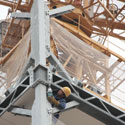Filter by
You must be a CTBUH Member to view this resource.
T30 Hotel
T30 Tower Hotel
Building
Completed, 2012
hotel
steel
99.9 m / 328 ft
30
1
330
65
3
2.5 m/s
17,338 m² / 186,625 ft²
Proposed
Construction Start
Completed
Usually involved in the front end design, with a "typical" condition being that of a leadership role through either Schematic Design or Design Development, and then a monitoring role through the CD and CA phases.
The Design Engineer is usually involved in the front end design, typically taking the leadership role in the Schematic Design and Design Development, and then a monitoring role through the CD and CA phases.
The main contractor is the supervisory contractor of all construction work on a project, management of sub-contractors and vendors, etc. May be referred to as "Construction Manager," however, for consistency CTBUH uses the term "Main Contractor" exclusively.
You must be a CTBUH Member to view this resource.
Usually involved in the front end design, with a "typical" condition being that of a leadership role through either Schematic Design or Design Development, and then a monitoring role through the CD and CA phases.
The Peer Review Engineer traditionally comments on the information produced by another party, and to render second opinions, but not to initiate what the design looks like from the start.
The Design Engineer is usually involved in the front end design, typically taking the leadership role in the Schematic Design and Design Development, and then a monitoring role through the CD and CA phases.
The main contractor is the supervisory contractor of all construction work on a project, management of sub-contractors and vendors, etc. May be referred to as "Construction Manager," however, for consistency CTBUH uses the term "Main Contractor" exclusively.
Changsha Regional Tour Report
20 September 2014 - Event
Atlantic Yards B2 – Modular on the Rise
24 July 2013 - Event

03 July 2014 | Changsha
Time lapse of T30 Hotel being constructed in just 15 days.

03 July 2014 | Changsha
Time lapse of T30 Hotel being constructed in just 15 days.

07 November 2013 | Changsha
Interview: BSB Prefabricated Construction Method
Shuguang Wang discusses the Broad Sustainable Building Prefabricated Construction Method, a Tall Building Innovation Award Co-Winner. He talks about the innovative new pre-fabrication technology and...

07 November 2013 | Changsha
Tall Building Innovation Award: BSB Prefabricated Construction Method
Never before has an entire prefabricated building system been developed to this degree. The BSB Method is a clear and innovative way of fundamentally rethinking...

21 September 2012 | Changsha
Interview: Broad Sustainable Building
Ying Tang of Broad Sustainable Building is interviewed by Jeff Herzer during the 2012 CTBUH Shanghai Congress at the Jin Mao, Shanghai. Ying Tang discusses...

21 September 2012 | Changsha
Interview: Prefabrication in the Tall Building Industry
Andy Davids of Hyder Consulting is interviewed by Jeff Herzer during the 2012 CTBUH Shanghai Congress at the Jin Mao, Shanghai. Andy discusses the 838-meter...
21 September 2014
The tour began with the Broad Sustainable Building (BSB) campus including the New-Ark Hotel. The group also visited Broad’s construction site of a 59-story tower.
24 July 2013
It seems increasingly evident that 2013 will be remembered as The Year of Prefab in the tall-building community. At 32 stories, B2 promises to become the tallest modular building.
23 September 2012
Attendees enjoyed an exclusive tour of the China Broad Group Facilities and spent the night in the T30 Hotel. The tour covered the company's manufacturing and research facilities.
Subscribe below to receive periodic updates from CTBUH on the latest Tall Building and Urban news and CTBUH initiatives, including our monthly newsletter. Fields with a red asterisk (*) next to them are required.
View our privacy policy